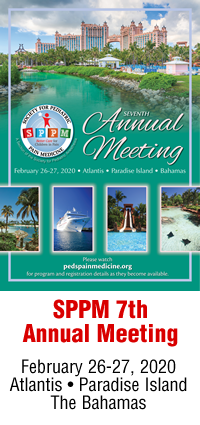AAP Update
Report From the AAP
By Rae Brown, MD
Former Chair, Section on Anesthesiology and Pain Medicine
The American Academy of Pediatrics
Professor of Anesthesiology and Pediatrics
The University of Kentucky
 |
Dr. Brown |
As I pen my last report to the Society, on November 1 I turned over the reins of the section to Anita Honkanen, MD. Anita is an expert in Pediatric Anesthesia and will continue to develop the relationship between the American Academy of Pediatrics and the Society for Pediatric Pain Medicine.
As I fade to dark, I would like to speak to the vital place that SPPM plays and will continue to play in the field of Pediatric Pain Medicine (PPM). We are witness to a pivotal period for the subspecialty and the growth of PPM. In many ways, 2019 for PPM has parallels to the development of Pediatric Anesthesia in the 1990s.
Over the last twenty-five years, we witnessed the growth of pediatric anesthesia as a unique body of scientific knowledge and research. Now, this subspecialty has its unique place in medicine. In the next ten years, we will witness similar growth in pediatric pain medicine. This growth, however, will be predicated on leadership that brings together all of the areas within the specialty – pediatrics, anesthesia, rehabilitation, psychology, and nursing. These separate bodies of knowledge must be acknowledged for the critical role that each plays in treating a significant pediatric chronic disease.
Each must be integrated into a single organizational structure for PPM to be recognized for what it is, an entirely new body of knowledge worthy of a place in the medical home. Acknowledging the multidisciplinary nature of PPM, at a level that transcends other aspects of pain medicine, highlights the distinctive elements of the specialty and differentiates it from the practice of adult pain medicine.
There is much work to be done to raise PPM to a level where it is acknowledged as unique and separate. The relationships between the SPPM and the AAP must continue to grow. Many pediatric pain medicine practitioners, going forward, are likely to come from the ranks of subspecialty pediatricians. We must recognize the need for all medical interests to have an opportunity for involvement to meet the demand for sophisticated pain care for thousands of children.
A central and all-encompassing professional organization that speaks to all that have an interest in PPM must be born. For this organization to gain recognition as representative of all clinicians, each must be invited into an organization where all are equal. The SPPM has started this work. Next steps include:
- Communication between the leadership of the SPPM and the Anesthesiology and Pain Medicine Section of the AAP,
- Support for the multidisciplinary group currently focused on subspecialty certification in conjunction with the American Board of Anesthesiology and the American Board of Pediatrics, and
- Recognition of interest groups within the American Psychological Association and the SIG for the International Association for the Study of Pain.
In 2019, SPPM is well placed to be the home for the further development of this unique specialty. The foundations for growth have been set. The hard work now begins.




